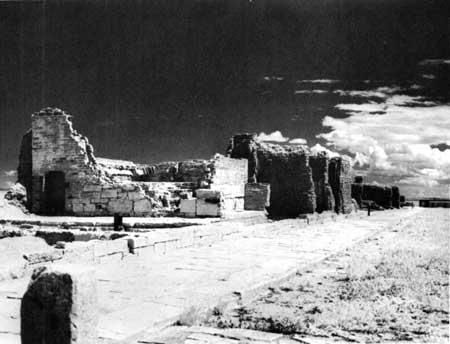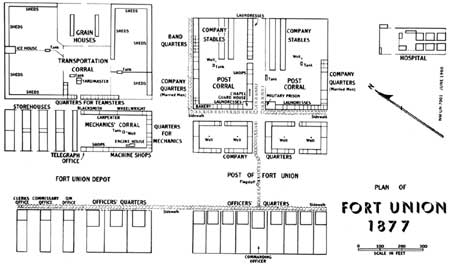|
FORT UNION National Monument |
 |

Ruins of the post bakery oven. Flagstone sidewalk in foreground
was uncovered by excavation.
Life at Fort Union
Scouting, patrols, and campaigns relieved the tedium of a daily life that varied only in minor details throughout the year. The official routine and the off-duty pastimes an Fort Union were duplicated at every frontier station in the West. Life was hard, but for many who served there the hardship only added no the nostalgia of later memories.
Of all Fort Union residents, the private soldier led the hardest life. Many were immigrants, chiefly German and Irish, only recently off the boat; others were the dregs of eastern society, those who lacked either ability or desire to find a better job; some were fugitives from justice, from business failure, from a shrewish wife, or from family responsibilities; a few were adventurers who liked soldiering. Meager pay, monotonous fare, hard work, and above all strict discipline made the private's lot an unenviable one. Officers and noncommissioned officers wielded awesome authority and awarded cruel punishment for minor infractions of the regulations. Desertions were common, and the deserter who failed to escape his pursuers suffered a retribution swift and severe.

(click on image for an enlagement in a new window)
Guard mount and the evening retreat parade, replete with field music, gold braid, and snapping guidons, roused a degree of martial ardor. But for the most part, the duties of the day seemed unheroic. The men drilled, practiced target firing, cared for weapons and horses, policed the grounds, and performed a variety of fatigue labors. Officers and noncommissioned officers supervised every activity. Lieutenants detailed as commissary and quartermaster officers carried out the necessary function of keeping the troops fed (beef, bacon, salt pork, beans, hardtack, desiccated vegetables, and coffee), clothed (rough, heavy woolens in all seasons), housed (communal barracks, grass-filled mattresses, springless wooden bunks), and supplied. Presiding over the whole from the headquarters building sat the commanding officer, and in an adjoining office two powerful voices of his authority, the adjutant and the sergeant major.
A typical day in garrison, regulated by the orderly trumpeter at headquarters, went like this:
| Reveille | Sunrise |
| Stable Call | Immediately after |
| Sick Call | 7:15 a.m. |
| Breakfast Call | 7:20 a.m. |
| Fatigue Call | 7:50 a.m. |
| Grazing Call | 8:30 a.m. |
| Guard Mount | 8:45 a.m. |
| Water Mount | 9:30 a.m. |
| Drill Mount | 10:30 a.m. |
| Recall from Drill | 11:30 a.m. |
| Recall from Fatigue, dinner | 12:00 noon |
| Sergeant's Call | 12:00 noon |
| Fatigue Call | 12:45 p.m. |
| Drill Call | 1:00 p.m. |
| Recall from Drill | 2:00 p.m. |
| Water Call | 3:00 p.m. |
| Stable Call | 4:30 p.m. |
| Recall from Fatigue | 5:10 p.m. |
| Dress Parade and Retreat | 5:45 p.m. |
| Dinner | 7:00 p.m. |
| Tattoo | 8:00 p.m. |
| Taps | 8:30 p.m. |
With promotion slow (lieutenants with 20 years service were not uncommon), officers jealously guarded the prerogatives of rank. A rigid caste system dominated human relationships. Rank determined one's privileges, authority, and social standing in the military community. When an officer reported for duty an Fort Union, for example, there might ensue a wholesale exchange of housing. A new officer had his choice of all quarters occupied by officers his junior in rank. A bachelor major might evict a captain with a large family from a 3-room apartment, thus leaving the captain to evict some hapless first lieutenant and his wife from a 2-room apartment. The lieutenant complied, however, for one day he too would wear the shoulder straps of a captain or perhaps even the gold oak leaves of a major.
The overriding condition of life an Fort Union, as at virtually every western post, was monotony. Field service occasionally relieved the boredom, and everyone except the wives eagerly anticipated in. But at other times the weeks seemed endless, all the more so because of the isolation. Las Vegas was 26 miles distant, Santa Fe almost 100. Residents of Fort Union had thus to entertain themselves.
Drinking and gambling headed the list of diversions. The post sutler's store, with its billiard and card tables and, when regulations permitted, its bar, was the center of this activity. For the enlisted men, the Mexican village of Loma Parda, 5 miles to the southwest, offered amusements to please every appetite. Primed with Army dollars, the town rocked with nightly revelry and drove many a post commander to the verge of distraction.
Also popular were hunting and fishing. Deer and antelope roamed the prairies surrounding Fort Union, and trout streams in the mountains beckoned the angler. Although enlisted men enjoyed these sports, officers were passionately addicted. They lavished much time and affection on their hunting dogs and horses and on their game rifles.
Reading was a favorite pastime. The post library subscribed to such periodicals as Harper's Weekly and Frank Leslie's Illustrated Newspaper. It also provided many of the popular paperbacked novels of the day, together with some heavier reading for the more intellectually inclined. Everyone thirsted for news of the outside world, and newspapers, usually a month or more old, were passed from hand to hand until read to shreds.
The women organized social events on the slightest pretext. Most cherished were the times when general courts-martial convened at Fort Union, bringing friends from other posts, but at all times the officers and their wives were planning diversions of one kind or another.
Formal dinners, with fine silver, china, and linen assembled from several households and with champagne and tinned delicacies purchased an the sutler's store, were frequent occurrences. Much time and effort went into planning and staging amateur theatricals, called charades. Weddings were gala affairs, with the preparations absorbing as much enthusiasm as the ceremony and attendant festivities themselves.
If a regimental band happened to be stationed at the post, balls were regular and well attended. "The quarters at Fort Union" recalled an officer's wife, "had an unusually wide hall which was superb for dancing, and three rooms on each side. We had only to notify the quartermaster that a hop was to be given, when our barren hallway would immediately be transformed into a beautiful ballroom, with canvas stretched tightly over the floor, flags decorating the sides, and ceiling so charmingly draped as to make us feel doubly patriotic." The men turned out in dress uniforms, the women in ball gowns fashionable when last they had been stationed in the East. Led by the impressively dignified bandmaster, the musicians poured forth marches, waltzes, and polkas. Between dances, the men gathered with cups and cigars at the punchbowl. Often, the festivities ended only with the approach of reveille.
Desperately and continuously, the Army people fought to overcome the monotony of garrison life. Never did they entirely succeed.

|
|
Last Modified: Sat, Sep 28 2002 10:00:00 pm PDT |


